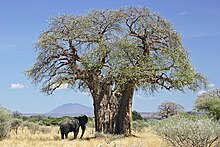
Back Adansonia digitata Afrikaans ባምባ Amharic Adansonia digitata AN Bawobap ANN تبلدي إصبعي Arabic تبلدى اصبعى ARZ Adansonia digitata AST Baobab Azerbaijani Баабаб Byelorussian Същински баобаб Bulgarian
| African baobab | |
|---|---|

| |
| Mature, flowering tree in Tanzania | |
| Scientific classification | |
| Kingdom: | Plantae |
| Clade: | Tracheophytes |
| Clade: | Angiosperms |
| Clade: | Eudicots |
| Clade: | Rosids |
| Order: | Malvales |
| Family: | Malvaceae |
| Genus: | Adansonia |
| Species: | A. digitata
|
| Binomial name | |
| Adansonia digitata | |
| Synonyms[1] | |
| |
Adansonia digitata, the African baobab, is the most widespread tree species of the genus Adansonia, the baobabs, and is native to the African continent and the southern Arabian Peninsula (Yemen, Oman). These are long-lived pachycauls; radiocarbon dating has shown some individuals to be over 2,000 years old. They are typically found in dry, hot savannas of sub-Saharan Africa, where they dominate the landscape and reveal the presence of a watercourse from afar. They have traditionally been valued as sources of food, water, health remedies or places of shelter and are a key food source for many animals. They are steeped in legend and superstition. In recent years, many of the largest, oldest trees have died, for unknown reasons. Common names for the baobab include monkey-bread tree, upside-down tree, and cream of tartar tree.
- ^ "Adansonia digitata L." Plants of the World Online. Royal Botanic Gardens, Kew. Retrieved 19 February 2022.